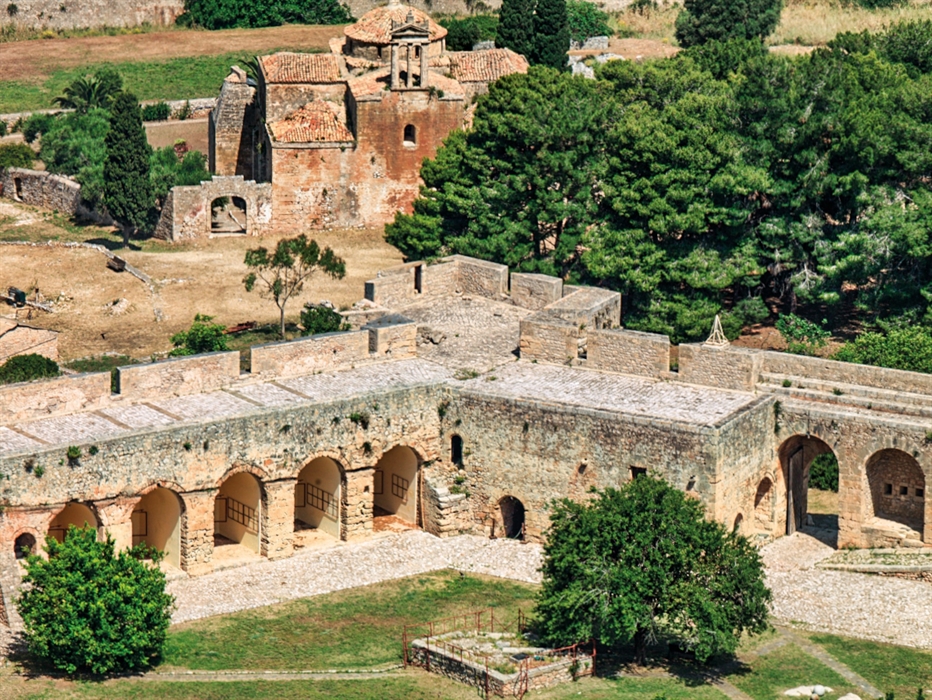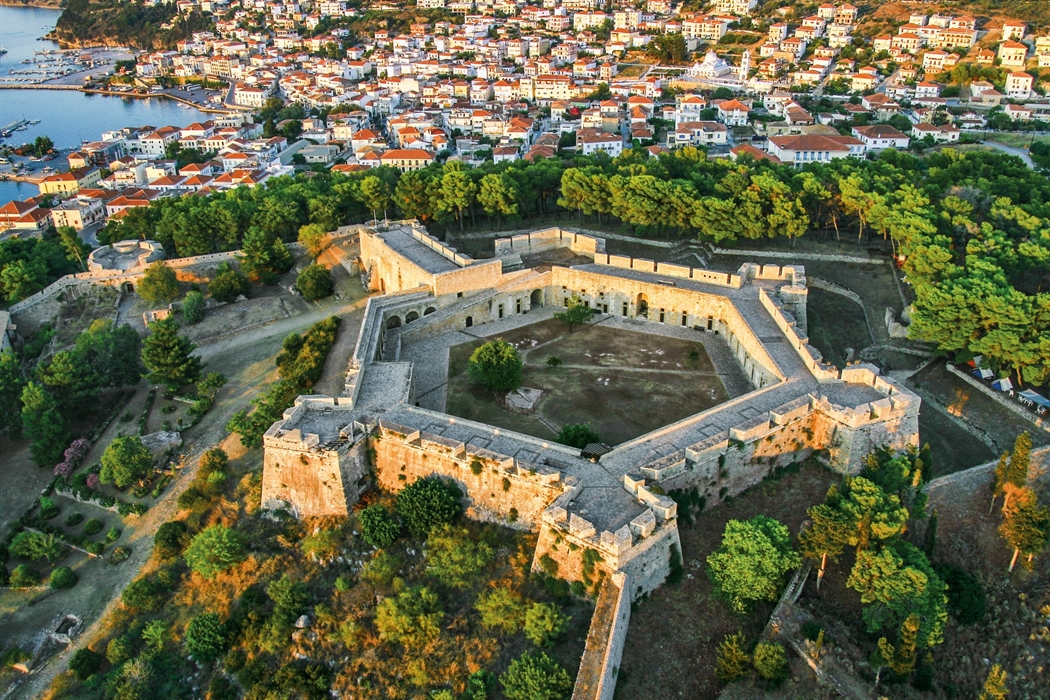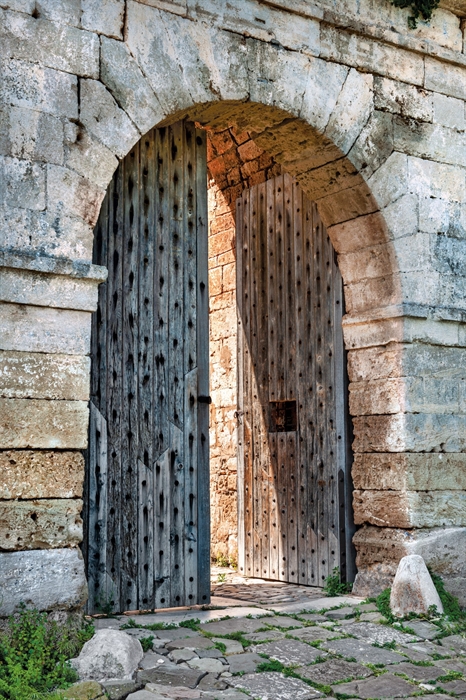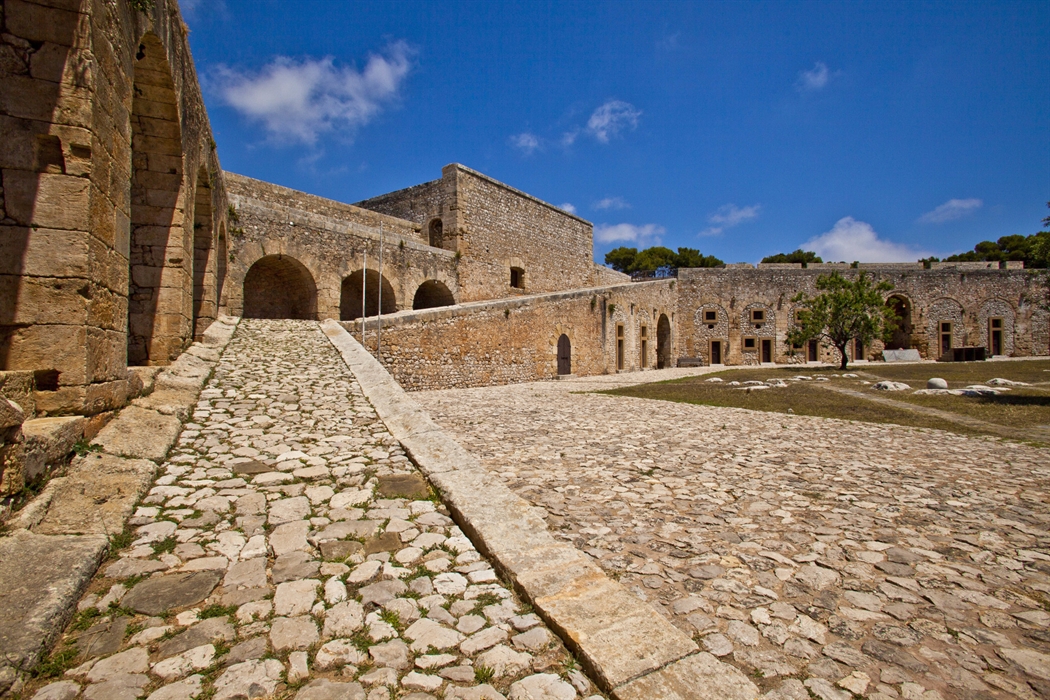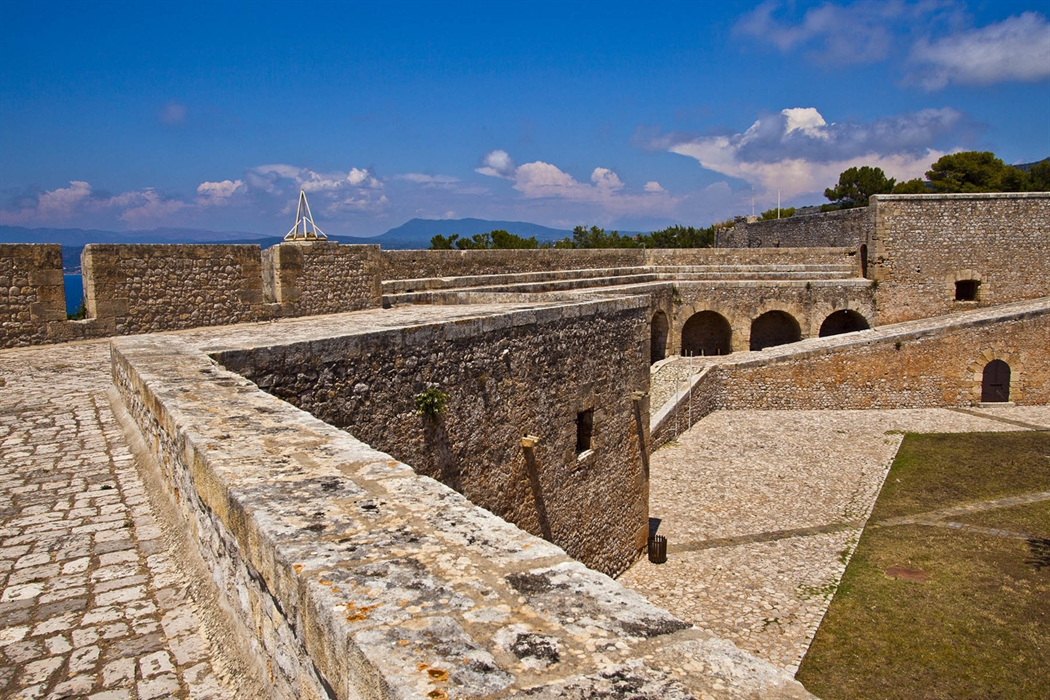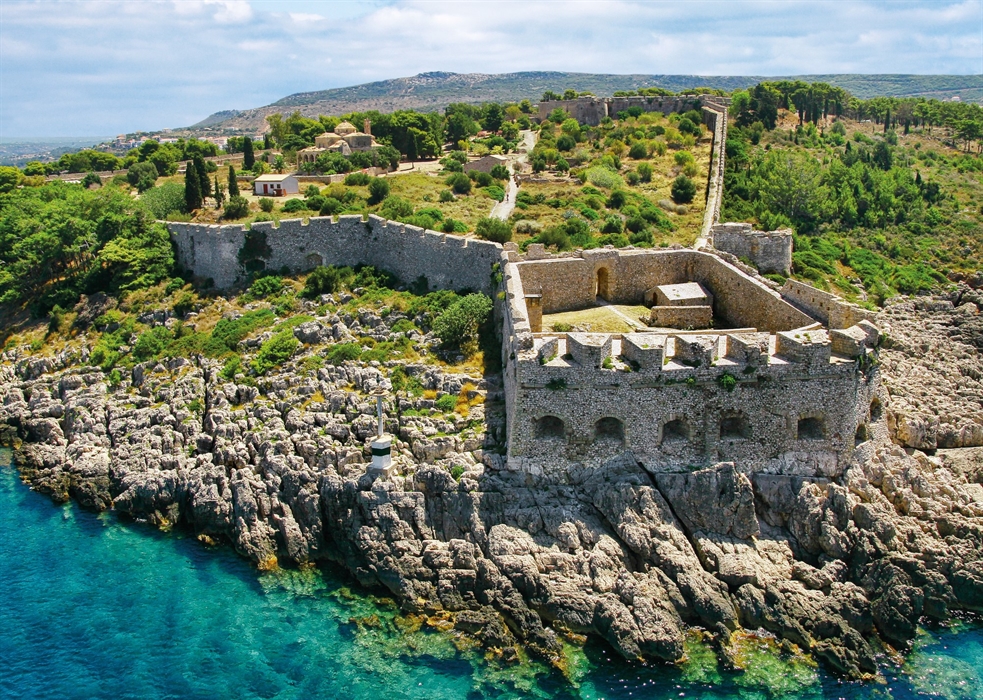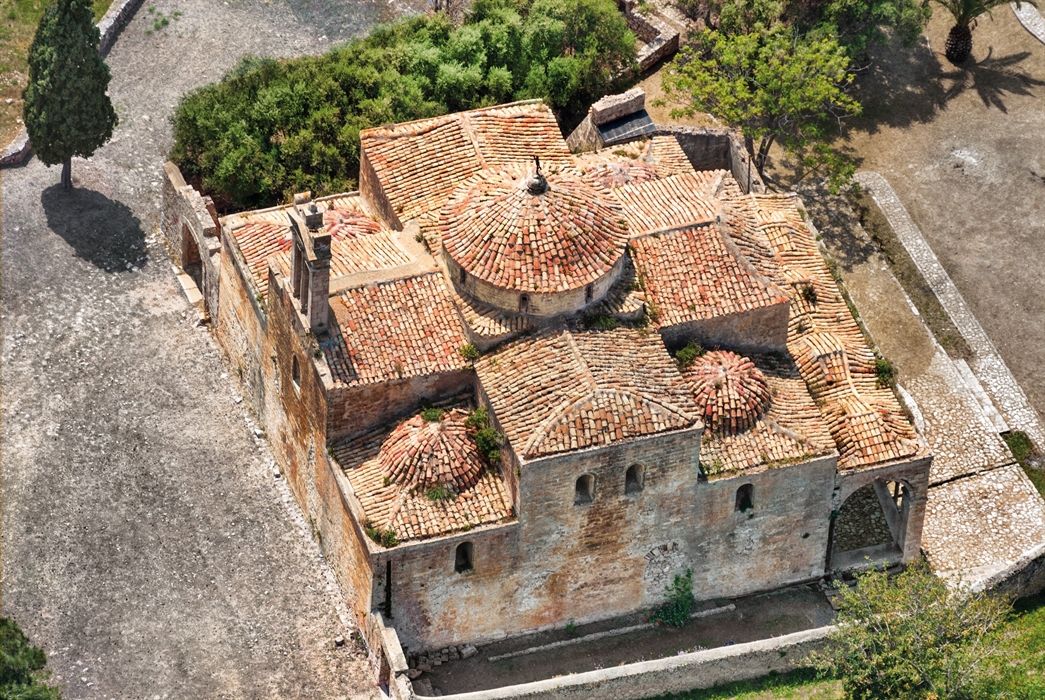Pylos New Navarino Fortress (Niokastro)
This impressive castle may be called the New Navarino Fortress, but it was actually built in 1573! It is inextricably linked to the city of Pylos, and its stature and position reminds us of the important role the area played over the centuries. There is a lot to see here -an impressive church, museums, a beautiful courtyard, walls, ramparts and, of course, a spectacular view of the Navarino Bay.
The New Navarino Fortress is inextricably linked to the city of Pylos. Its stature and position reminds us of the important role played in the area over the centuries. There is a lot to see here -an impressive church, museums, a beautiful courtyard, walls, ramparts and, of course, a spectacular view over the Navarino Bay.
The New Navarino Fortress (Niokastro), was built by the Ottomans in 1573 to control the southern entrance to Navarino Bay and the East-West trade sea route after they were defeated in the battle of Nafpaktos. At 450 years old, it’s not exactly new, but it is called the “new castle” in comparison to the Old Navarino Fortress (Palaiokastro).
Like most of the castles in Messinia, this fortress has had an “interesting life” and it played a starring role in events that sealed the modern history of Greece.
Over the years, it has passed from the Ottomans to the Venetians (1686) and then to the Ottomans again (1715). It remained under Ottoman rule until 1828 when Ibrahim Pasha’s forces left the Peloponnese. In the second half of the 19th century and up until the middle of the 20th century the fortress citadel was used as the Pylos prison, and during the Second World War it was used as the Italo-German headquarters.
The fortress covers a large area (approximately 70,000 sq.m) and there are lots of buildings to explore: residences, public buildings, barracks and a mosque which has been converted into an Orthodox church. Wandering through at your own pace, you can get a feeling for what life must have been like for all those who lived and fought here in the past.
The New Navarino Fortress was built at a time when the discovery of gunpowder and the use of firearms had a major influence on defensive architecture, hence the fortified bastions. The two most important bastions -Bastion Seven and Bastion Santa Maria- are on the sea-facing side of the fortress and protected the entrance and the port.
It was also protected by huge thick walls built to withstand attacks by enemy cannons. Impressively large sections of these walls are still more or less intact, and you can see some of the old cannons (and cannonballs) that were once used to defend them. The highest and most vulnerable point of the castle was defended by the citadel which was reinforced with an arid moat on the outside, six bastions and almost sixty cannons.
The main entrance to the fortress was to the southeast, from the "Scalding Gate" (Zematistra).
Watch out for the Maizonos Barracks, the impressive two-story stone building with a gabled roof which was built by the French expeditionary force after 1828 and named after the General. The building now houses the Archaeological Museum of Pylos with exhibits which trace the history of the area from remote prehistory to Roman times.
Two spaces in Niokastro house exhibitions created by the Ephorate of Underwater Antiquities, presenting information, photographic material and findings during the research of experts.
One exhibition can be seen in the Pasha building, built between the 17th and 18th centuries. It is designed to give the feeling of the seabed and is entitled: "Sunken Journeys, Human Explorations: Significant Traces in the Seas of the Peloponnese". It presents, among other things, the wrecks of the kions and amphorae that exist near Sapienza in the Messinian Oenousses.
The second exhibition entitled "Ancient Sunken Cities of the Southern Peloponnese" is located in the Makriyannis bastion. It includes information and exhibits about the submerged city at Pavlopetri (near Elafonisos), Plytra and Methoni.
Transfiguration of the Saviour church
Finally, don’t miss the Transfiguration of the Saviour church which was built during the reign of Sultan Murad III as an Ottoman mosque. During Venetian rule (1686-1715), it functioned as a Catholic church and then, when the new Greek state was established, it became a Greek Orthodox church. It has an octagonal dome, is supported on four massive pillars and is surrounded on three sides by an enclosure. Works by the Directorate of Byzantine and Post-Byzantine Antiquities were carried out to highlight its original architectural form and the different phases in its building. Among other things, the porch, the minaret and the bell tower were restored.
Did you know that
Summer opening hours of the castle and the museums: 08.00-20.00. Winter: 8.30-15.30. Closed Tuesdays. It is accessible for people with disabilities.
Tel. 27230 22955.
Cultural events and concerts are organized in the New Navarino Fortress.
Location
Find the destination on the interactive map below.
Categories
Weather
Σχετικό περιεχόμενο χρηστών (UGC)
Ενημερωθείτε για ενδιαφέροντα θέματα γύρω από τον προορισμό μέσα από το περιεχόμενο των χρηστών μας
Discover 7 hidden gems of the Peloponnese
Many of you may have already visited some of the most renowned attractions…
TOP 10 archaeological museums in the Peloponnese
Olympia, Mycenae, Epidaurus, Diros Cave, Ancient Corinth, Messene and…
TOP 10 Castles in the Peloponnese
Castles galore! Mystras, Monemvasia, Palamidi, Methoni, Koroni,…
Newsletters
- About us
- FAQ's
- Map
- Tourism information centers
- Disclaimer
- Sitemap
- Our brand
- Media roum
- Adding your bussiness
- Corporate
- MICE

Peloponnese. Greece beyond the obvious





Design and creation from Cosmote
Marinas and Moorings
Diving centers
Get inspired
- Media gallery
- Blog
- The Peloponnese in the media
- Your feedback
- Users' general content
- Users' local products
- Users' events content
- Ask a local
More
- Accommodation
- Travel agencies
- Restaurants
- Services
- Destinations Map
- Weather
- Public transport
- Events
- Frequently asked questions
- Useful phones
- B2B
- Destination Data
- Contact

